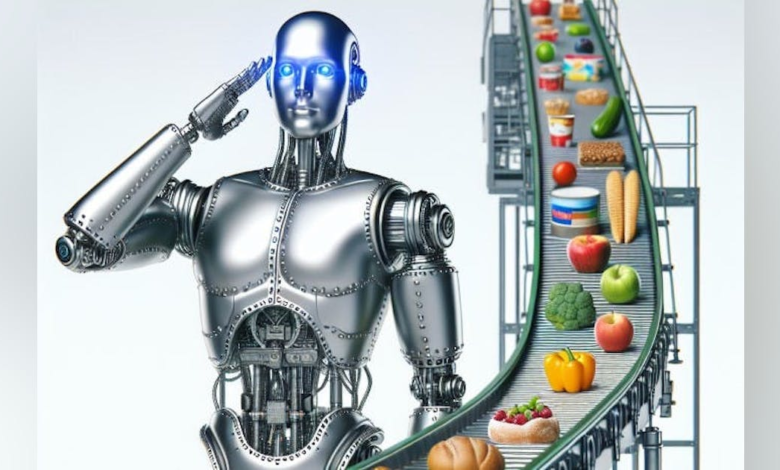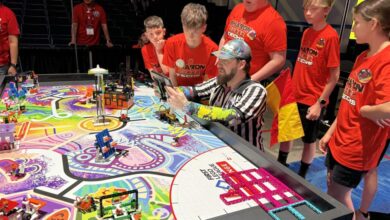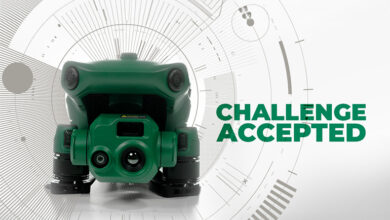Robots Take on More Food Processing Tasks

Is there no end to what robotics can do? Food & beverage operations are finding out, with the roadblocks getting fewer and farther between every day.
For what once appeared to be a futuristic notion, food & beverage processors today have implemented robotics in their plants to improve operational speed, efficiency and throughput, all while eliminating jobs that either presented safety hazards for employees or simply couldn’t be filled. And it’s no wonder, if you ask Mike Noonan, vice president of operations for Bitchin’ Sauce LLC.
“Machines don’t call out sick and can run 24/7, so they are really useful in a lot of our applications,” says Noonan, whose company contracts out manufacturing of its products. “I do not mandate that facilities use the technology, but I’m attracted to facilities that do have it, because you can depend on their output.”
Take heed, processors, but fear not: There remains plenty of opportunity for robotics innovation that can increase that dependability.
“It’s a very interesting time to be in the field [of robotics]; there’s a lot of opportunity out there,” says Colin Usher, senior research scientist and head of the robotics branch of the Intelligent Sustainable Technologies Division at Georgia Tech Research Institute (GTRI). “It’s just capturing that and proving that it can work.”
Currently, Usher says, the largest applications of robotics in food processing remain case-packing, pallet-handling and material-transfer operations, where processors are moving one product from a belt to another in a singulated fashion. Processors are using the classic, articulated robotic arms as well as SCARA (selective compliance assembly robot arm) and delta robots to perform these tasks. Delta and SCARA robots excel when processors need high-speed pick-and-place tasks performed, Usher adds.
New frontiers continue to open, however, with robots taking on more applications every day. Usher says some cheese manufacturers have taken the next step to use robots to handle both the slicing and packaging of cheese, while other niche applications have cropped up in other segments of the industry.
“For example, for knife sharpening, poultry processors now have stations where they bring all of the knives at the end of the shift and feed them into a drawer, and a robot picks them up and sharpens them,” Usher says. “This guarantees really even sharpness across the blades, which you might not get with a human performing the task.”
Barriers lowering slowly
For all the advances in robotic technology, no one should expect it to be implemented en masse in processing plants just yet. Hurdles prevent a full-scale robot takeover — but also show the way toward opportunities in food & beverage processing, where improved robots can help once they overcome the dexterity requirements or the need for flexibility due to production of multiple SKUs in a facility.
“Robots are still very much ‘fixed’ automation,” Usher says. “They are a one-task system — they do one thing really well and if you change it, then you’ve got to go back to the drawing board. They’re still not very adaptable, but we are seeing slow changes on that front.”
Noonan confirms how a wide portfolio, similar to what Bitchin’ Sauce offers, can present challenges for an operation.
“We do have a lot of flavors and we do a lot of changeovers, so running all of those flavors and having them be available for our customers can add downtime to our manufacturing facilities,” he says. “But I’ve spent a lot of time in manufacturing, and I understand the headaches and hurdles that they have in these facilities, so I try to aid our partners as much as possible and simplify.”
A decade or more ago, he adds, some wondered why robots didn’t look like humans or arms with fingers and the like, but design was limited by computational power and the one-task needs. Humans, on the other hand, are considered to be great generalists, built to handle multiple tasks and to be flexible in their actions.
“Well, we’re coming back around now to where you need a generalist, not a specific task-oriented system,” Usher says. “So there’s a lot of movement in these humanoid robotics or multi-fingered, dexterous manipulators.”
In response, the academic community has taken the baton on controls theory, artificial intelligence and how to teach these new generalist robots to move and manipulate objects. Over the next decade, Usher says, the industry could see significant changes bringing about a new generation of robotics.
“Just the scale of AI and data centers that are going up will give new capabilities to robots and technologies that are going to be pretty eye opening,” he says. “I think we’re going to see some vast changes in the landscape of what these systems can do and where they could fit.”
There will be bottlenecks in the development around energy and computational power, but time and investment will likely solve those issues on a more gradual basis as data centers spring up. By then, the cost of robotics ought to come down further, as it has in the last five to 10 years.
Despite that slide in costs, however, processors still find ROI to be a challenge. Although the food industry continues to struggle to hire and keep employees, Usher says labor still costs relatively less than some of the robotics systems available, and that has slowed implementation for some.
“They’re still fairly expensive systems, but the applications become more attractive when the price drops,” he says. Finally, the ability for robots to coexist on processing floors, where sanitation methods are harsh and standards are strict, remains a challenge, Usher says, but there have been positive signs over the years.
“Several companies now have washdown, food processing-ready robots, where that wasn’t the case five or six years ago,” he explains. “You just couldn’t find those options, but now they are moving in and getting into more applications.”
On the horizon
Advancement in the dexterity of robotics continues, Usher says, and improvements in sensors have helped spur innovation there. These technologies help robots do more dexterous handling and product manipulation, such as picking, orienting and placing chicken breast product in trays. AI and advanced sensing techniques have begun bridging some gaps, but robots still cannot handle higher complexity material handling tasks just yet.
Bitchin’ Sauce uses high-pressure processing (HPP) on its products, which still is a very batch-oriented process due to the loading and unloading of the product into the HPP vessels. Noonan hopes robotics might lend a hand there.
“We are experimenting a little bit with how product can go as quickly as possible from the production line to the HPP machine, and then automate that loading process,” he says “You take away the bottleneck of loading the machines, and you then also need less labor to load product and keep the facility running.”
Usher says his group at GTRI is currently working on a robot assist when it comes to complex handling tasks — putting a human operator in a virtual-reality system and having them remotely control the robot on the processing line.
“The robot can carry out the autonomous task: It knows how to pick up a product and move it, but what it might not [know is] how that product is oriented, how to pick it up or how to place it,” Usher explains. “So we put a person in a virtual reality headset and let them just click, click, click, click to tell the robot where the product is, what to do with it and where to move it.”
Furthermore, GTRI’s team is working on ways to incentivize and gamify the work, because it can be tedious, even if the human isn’t standing in the harsh environment of the food and beverage processing floor. And as data is captured, the robots can learn through AI, leading to potential automation of the process down the road — which means the humans can move on to higher-quality work in another area of the facility.
And as robots continue to develop improved capabilities, they can make food & beverage processing easier on the humans in charge of operations, who can turn their focus to other areas of the business.



